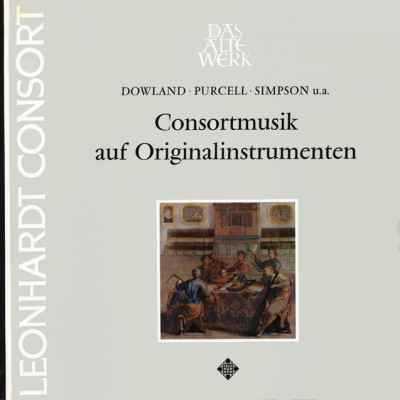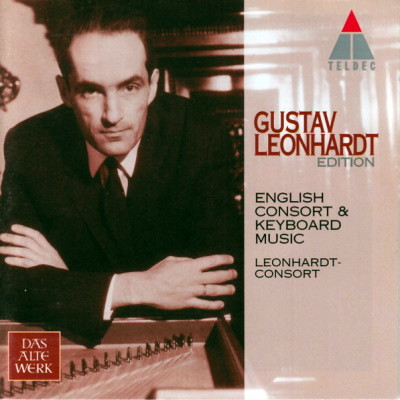 |
|
1 LP -
SAWT 9576-B - (p) 1971
|
 |
| 2 CDs -
3984-21760-2 - (c) 1998 |
|
| CONSORTMUSIK
AUF ORIGINALINSTRUMENTEN |
|
|
|
|
|
|
|
|
| John DOWLAND (1562-1626) |
Pavan
in C - 4-stimmig |
|
|
5' 04" |
A1 |
| William LAWES (1602-1645) |
Suite
Nr. 1 in C - 6-stimmig |
*
|
|
12' 29" |
A2 |
|
-
Fantasia
|
|
4' 59" |
|
|
|
- In
Nomine |
|
4' 09" |
|
|
|
- Air
|
|
3' 28" |
|
|
| John COOPER [Giovanni
Coperario] (1575-1626) |
Fantasia
- 5-stimmig |
|
|
3' 10" |
A3
|
|
Suite
- 3-stimmig |
|
|
6' 35" |
B1 |
|
-
Fantasia |
|
3' 01" |
|
|
|
-
Alman |
|
1' 44" |
|
|
|
-
Galliard
|
|
1' 53" |
|
|
| Thomas SIMPSON (geb. c.1582) |
Ricercar
"Bonny sweet Robin" (1621) -
4-stimmig |
|
|
3' 09" |
B2 |
| Henry PURCELL (1659-1695) |
Triosonate
VI in g |
|
|
7' 55" |
B3 |
|
|
|
|
|
|
LEONHARDT-CONSORT
(auf Originalinstrumenten)
- Marie Leonhardt, Barockvioline
(Jacob Stainer, 1676)
- Antoinette van den Hombergh, Barockvioline
(Michele Platner, Rom ca. 1740)
- Wim ten Have, Barockviola (Joseph
Hill, London 1770)
- Wiel Peeters, Barockviola (Johannes
Tononi, 16. Jahrhundert)
- Dijck Koster, Barockvioloncello
(Giovanni Battista [II] Guadagnini,
1749)
- Anner Bylsma, Barockvioloncello
(M. Gofrilleri, Venezia 1699)
Gustav LEONHARDT, Cembalo und
Leitung (Rainer Schütze, Heidelberg 1963,
nach niederländischem Modell, um 1700)
|
|
|
|
|
|
Luogo
e data di registrazione |
|
Westzaan (Holland) -
Novembre 1970
|
|
|
Registrazione:
live / studio |
|
studio |
|
|
Producer |
|
Wolf Erichson
|
|
|
Prima Edizione
LP |
|
Telefunken "Das Alte
Werk" | SAWT 9576-B | 1 LP -
durata 38' 22" | (p) 1971 | ANA
|
|
|
Edizione CD |
|
Teldec Classics
"Gustav Leonhardt Edition" | LC
6019 | 3984-21760-2 | 2 CDs -
durata 70' 20" 57' 02" |
(c) 1998 | ADD
|
|
|
Cover
|
|
"Musikalische
Unterhaltung am Tische"
(Ausschnitt), Gemälde von Johann
Heinrich Schönfeldt (1609 Biberach
- 1675 Augsburg). Gemäldegalerie
Dresden.
|
|
|
Note |
|
Non si è a conoscenza
della ripubblicazione in Compact
Disc della Triosonate VI in g
di Henry Purcell.
|
|
|
|
|
It is often
asserted in Europe, with
characteristic Continental
superiority, that the
British are an unmusical
nation, whose composers - in
comparison to those on the
mainland - have never
succeeded in climbing out of
a state of creative
turpitude. On closer
scrutiny, however, quite a
different picture offers
itself: the famous 13th
century canon “Sumer is
icumen in” - a document of
native polyphony, with its
fondness for minor thirds
and sixths, the existence of
organs with over 400 pipes
as early as the 10th
century, the “Golden Age of
Music” at the time of
Shakespeare and, last but
not least, the present
renewed impetus through
composers like Vaughan
Williams, Tippet and Britten
are proof that the British
have good reason to consider
themselves a nation creative
in music, whose leading
representatives have
extended their artistic
influence to the Continent
as well.
It was during the reigns of
Elizabeth I (1558-1603) and
James I (1603-1625) that
musical activity reached a
peak. With the arrival on
the scene of the Italian
madrigal English composers
made up hundreds of
delightful choral songs to
the musical recipes of Luca
Marenzio and Giovanni
Gastoldi. Although written
in imitation of the Italian
form, in their melodic line,
their essence, their
interpretation of the words
and their popular vein these
songs always retained their
English character. This was
the heyday of keyboard
music, whose varied art
forms are contained in the
“Fitzwilliam Virginal Book”,
dance forms flourished, as
did the solo lute song,
which, under Dowland,
reached a perfection which
has remained unsurpassed.
The most outstanding
characteristic of this
classic epoch, however, was
the cultivation of chamber
music, which outstripped all
other instrumental and vocal
forms and only towards the
end of the 17th century
yielded ground to the more
expansive orchestral style
of France’s Lully. Known as
“consort music” this purely
instrumental ensemble music
has retained its vitality
right up to the present day.
Two to six performers
usually participated in such
communal music-making, which
was generally restricted to
a private circle without an
audience. It was considered
the done thing (and numerous
members of the nobility and
high-ranking citizens were
known to be competent
musicians) to play as many
instruments as possible. A
particularly revealing
description of the English
consort was given by the
German composer and theorist
Michael Praetorius: “A
consort is when several
persons with all kinds of
instruments such as
clavicymbal or large spinet,
large lyre, double harp,
lute, theorbo, bandora,
zither, viola da gamba, a
small descant viol, a flute
or recorder sometimes even a
quiet trombone or rackett,
in an ensemble and company,
made music in accord, quite
gently, soft and sweetly,
and in graceful symphony
play together with each
other.”
This “playing together with
each other” is to be taken
literally. The works
presented here require a
carefully balanced
combination of sound from
the chosen instruments -
unlike the mere grouping of
a number of different
instruments of earlier
times. It is just these
early steps in true
instrumentation that give
the music its peculiar
charm: viols, recorders and
lutes sound most convincing
when played in a restrained,
quiet and objective manner.
Its fine, delicate lines, in
which the upper melody part
does not yet bear the main
weight of the emotional
content, are brought out
best through a reserved,
tempered mode of playing -
subjective emotionalism in
the performer would simply
mean a grotesque caricature
and hysterical perversion of
the original.
Uwe
Kraemer
|
  |
|
|